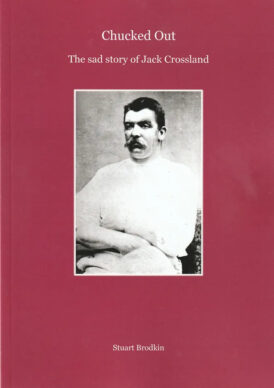Chucked Out: The Sad Story of Jack Crossland
Martin Chandler |Published: 2023
Pages: 52
Author: Brodkin, Stuart
Publisher: Red Rose Books
Rating: 3.5 stars

I have always maintained that the cause of my lifelong passion for cricket and cricket writing was Neville Cardus. Had I not, at an impressionable age, read his childhood memories of his Lancashire heroes my whole life may have been different.
Over the years my interest has been piqued by each and every aspect of the game’s history throughout the world, albeit I keep on coming back to Lancashire. Oddly though with the county I have always followed I seldom go back from Cardus’s time, so my knowledge of the the county’s cricket before the Golden Age is a little sketchy.
Which is not to say that the name of Jack Crossland is an unfamiliar one. I certainly recognise him as being a man whose name was caught up in a controversy about his bowling action, and that his county career had been a brief one, but until now the detail of his story had passed me by.
I now know that Crossland was a Nottinghamshire man, from the fertile cricket nursery of Sutton in Ashton. From playing professionally in the leagues he joined Lancashire in 1878 and, after a slow start to his county career, in 1882 his right arm fast bowling earned him a place at the head of the national averages after he took 112 wickets at just 10.06 runs each.
But the storm clouds were gathering and a divide opened up between Lancashire and most of the other counties over the fairness of Crossland’s action, not assisted by similar mutterings over teammates Alec Watson and George Nash, albeit none of the three were every actually no balled.
Lancashire stood up for their man, but they couldn’t fight the irregularities that were found with Crossland’s residential qualification and, courtesy of that, he was forced to leave county cricket at the, for those days, early age of 33.
Stuart Brodkin’s thoroughly researched booklet does tell the story of Crossland’s life, but it is primarily concerned with investigating the controversy over his bowling action. Many contemporary observers are quoted as Brodkin seeks an answer, but the inevitable absence of any film or photographic evidence makes a contemporary assessment extremely difficult.
Slightly to my surprise Brodkin does ultimately feel able to reach a conclusion taking the view, on balance, that Crossland’s action was illegal. My own take on that is that the most that can be said of Crossland was that his action appeared unusual, and of course recent experiences tell us that that is no guarantee of any illegality. But perhaps I have been a lawyer too long, and after all these years simply have too many splinters in my backside.
But whether his reader agrees with Brodkin’s conclusion or not is rather beside the point. What Brodkin unarguably does is put the case for both sides, and at the same time tell what is ultimately a sad story. In doing so he adds an interesting contribution to the written history of Lancashire cricket and he and publisher Red Rose Books are to be congratulated for their continued commitment to that cause. The booklet is available directly from the publisher in two formats, a paperback which costs £12 inclusive of UK postage and, for those of us who like that sort of thing, a signed limited edition of 25 hardbacks at £36 each.






Leave a comment